The Samsung Galaxy Note5 and Galaxy S6 edge+ Review
by Joshua Ho on October 2, 2015 8:00 AM ESTDisplay
With the rise of smartphones and tablets, the display has become one of the most important aspects of a mobile device as it’s the primary mode of interaction. However, throughout computing the display has generally had relatively little attention. People might have talked about resolution, size, and latency, but the discourse was vague at best. In order to really understand displays, it’s important to discuss a number of factors that affect display quality and the underlying design of the display. These factors range from subpixel arrangement to TFT structure and various emitter materials. With traditional reviewing methods, it’s often difficult to say one way or another whether one display is “better” than another. While simple metrics like maximum brightness can be compared in a relative manner, it’s hard to say whether one has better colors or higher static contrast. In order to test these metrics, we turn to objective measurements from devices like X-Rite’s i1Pro2 spectrophotometer and i1Display Pro colorimeter. In order to acquire the data from these devices and present it in a usable manner, we use SpectraCal’s CalMAN 5 with a custom workflow.
Under the microscope and based upon some quick viewing angle tests, subjectively the Galaxy Note5 display looks and feels like a bigger version of the Galaxy S6 display. Viewing angles for some angles feels like the display is almost painted on to the glass below, but some odd interference effects with viewing angle changes breaks the illusion to some extent. In the case of the S6 edge+, the curved edges of the display cause a noticeable shift in luminance when looking at the edge compared to the center of the display, which also causes an odd green shift which is probably due to the RGBG subpixel layout. I suspect the best LCDs will still be better at the “painted to the glass” illusion for the near future. This isn’t a huge deal, but it is a noticeable difference.
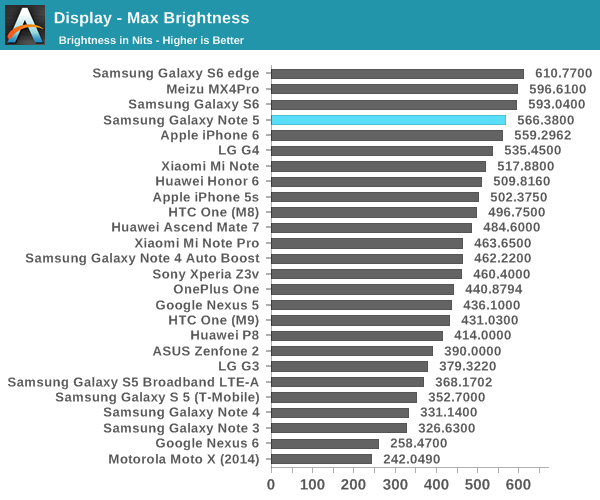
Moving on to our brightness testing, we can see that the Galaxy Note5 delivers a healthy improvement over the Galaxy Note 4 generation of AMOLED, but it isn’t quite at the same level as the Galaxy S6. It isn’t clear why this is the case, but I suspect this is related to longevity and other concerns outside of brightness. Meanwhile the use of OLED means that black levels are perfect and contrast remains solely determined by the lighting of the room and the reflectance of the display, which is similar to most other smartphones.
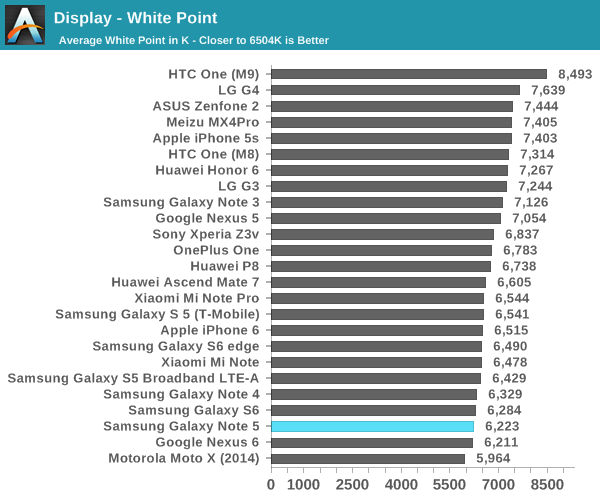
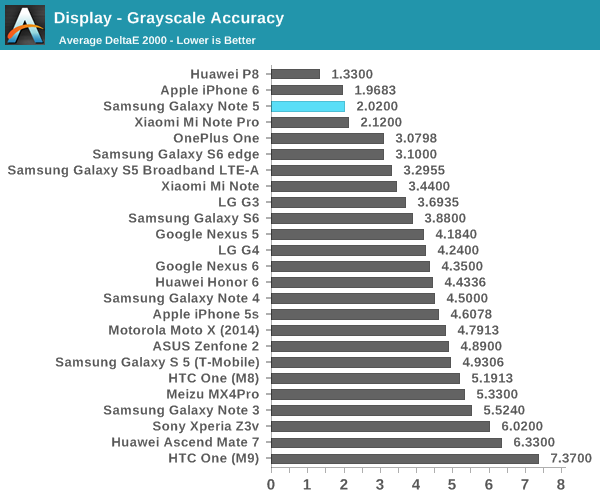
In our standard grayscale testing, the Note5 delivers acceptable color accuracy but it seems that the Basic screen mode tends towards a warm color balance. I suspect this helps with power efficiency, as blue in general requires more power to achieve the same level of luminance. Other than this slightly warm white balance, the grayscale accuracy doesn’t have any significant errors. This means accuracy ends up very good - certainly below our threshold for noticable errors - especially in comparison to the Galaxy Note 4 which had some noticeable problems with green tint on some units.
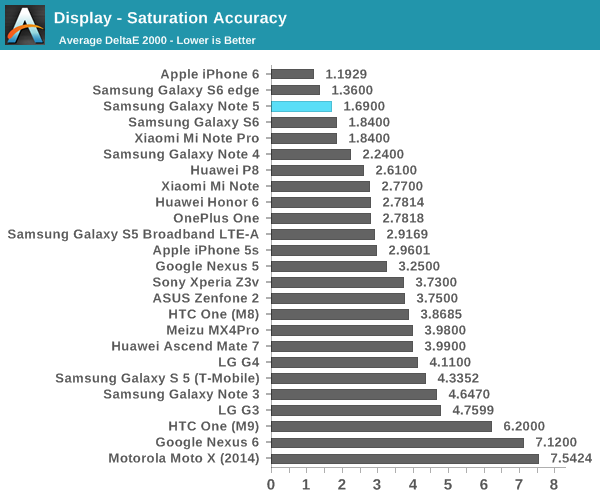
In our saturation test, Samsung does well enough that there’s really nothing to talk about because there's so little wrong here. You could argue that magenta is a bit warm on our review unit, but the difference is too small to be worth talking about. Error on average is going to be hard to spot unless you have a flawless reference monitor to compare against.
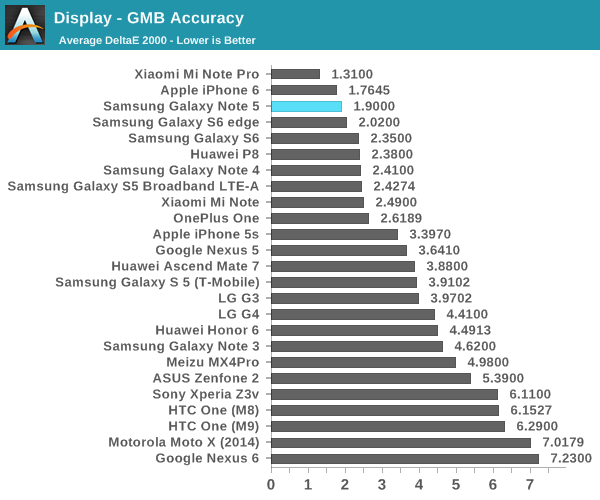
In the GMB ColorChecker test, Samsung continues to show a strong performance when looking at various hues that are commonly found in consumer content such as movies and camera photos. There’s a slight red shift on some of the tested hues, but the error is so minor I don’t notice that any problems here.
Overall, the Galaxy Note5 and Galaxy S6 edge+ both have an incredible display. The Galaxy S6 edge+ does have some problems with viewing angle shifts by virtue of the curved display, but this is effectively unavoidable given the subpixel layout and the radius of curvature. With this generation of AMOLED, Samsung has definitely equaled the best LCDs on the market. I suspect within the next year or two it will be inevitable that Samsung AMOLED will be clearly superior to even the best LCDs. However, without other OLED suppliers that can provide similar quality and cost I suspect OEM adoption will continue to be limited.



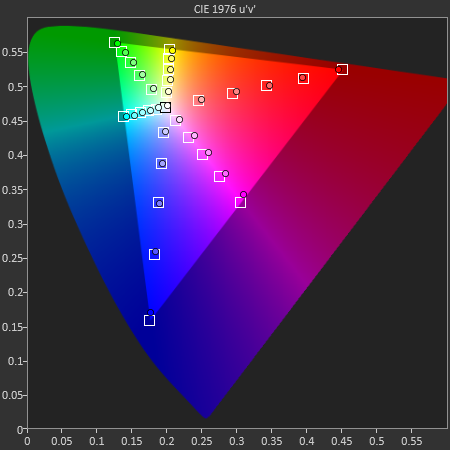
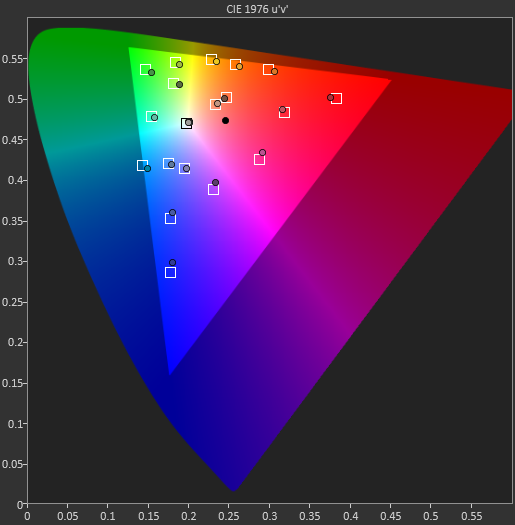








225 Comments
View All Comments
Kepe - Tuesday, October 6, 2015 - link
Read the entire page, please. They're comparing the designs of Note 4 and Note5, and that sentence describes the back of Note 4. That part of the review IS a bit confusing, though, but understandable if you concentrate on what you're reading.thedons1983 - Sunday, October 18, 2015 - link
You do realise though, that the feature YOU so clearly desire, is not even slightly relevant to the vast majority of smartphone users? That puts YOU in a subset, and therfore, YOU need to look harder when buying a device. The rest of the world, literally, could not care less. You're in the minority dude, pure and simple.hero4hire - Sunday, October 4, 2015 - link
I have a new Note 5 in box and am still using my Note 4. Microsd is the reason why.If I'd paid I would have 100% bought the 128gb version. As it is I'm not sure if I can use it.
Best alternative is to use another device to Bluetooth to my vehicle. Lack of a microsd option will hurt Samsung. We're not all interested in Knox and corporate security.
At least make a "virus allowing hacked unsafe dangerous murder bot phone with a death slot" (microsd) as an option. Your 14 arbitrary nearly identicle model selections prove you could do it.
Kepe - Tuesday, October 6, 2015 - link
If you don't want it, send it to me :pthedons1983 - Sunday, October 18, 2015 - link
No it won't... No-one, apart from butt hurt retards like you, give a flying fook about microSD. It's 2015, not 2010, so get with the times grandad. You've obviously never heard of the Cloud for a start.thedons1983 - Sunday, October 18, 2015 - link
No-one need microSD these days, unless you are an idiot. The Cloud exists, and is way more useful than local storage on a slow as hell and completely outdated format like microSD. The world has moved on grandad, so maybe you should too!!10basetom - Saturday, October 3, 2015 - link
The ability to use the Note 5 as a yellow sticky pad (i.e., write memo from sleep state) is a killer feature that will attract a lot of people, especially past Note users who left. I bought a Note II thinking that it can act as my digital notepad, but I ended up rarely touching the stylus because it was a hassle to claw it out of the silo, unlock the phone, and hunt down the memo app to launch it. With the Note 5's new abilities, I can see myself using the stylus on a daily basis and finally attain that seemingly always out-of-reach goal of having a digital notepad.eeg1 - Saturday, October 3, 2015 - link
the issue with samsung is not the phone but the horrible customer service which is why i would never buy a phone from them. the power plug of my brand new GS6 did not work. when calling customer service they asked i return the broken one before sending a new one. fine but how am i supposed to work for 2 weeks as they sorted out the issue. and when i complained i was treated like c*ap So much better with Apple. you go in and they fix everything for you on the spot no major Qs asked. I am glad samsung is losing a ton of share in the US. it will teach them to take their customers' hard earned money and loyalty for granted. here is to samsung zero market share. i even changed everything at home (3 TVs) to LG...terrible servicetheduckofdeath - Monday, October 5, 2015 - link
Did you really but your phone directly from Samsung? Or are you just another one of those Apple trolls posting your useless scripted BS? Yeah, that was a rhetorical question as we both know the answer to that question.Peichen - Monday, October 5, 2015 - link
You do know the Apple have 24/7 Apple Store in big cities right? What do you think those stores are for? Just because you are not used to 24/7 face-to-face support doesn't mean it is a bad thing.Apple also does cross shipping in case you don't know. You'd have 30 days to ship the bad parts back with the included envelope.